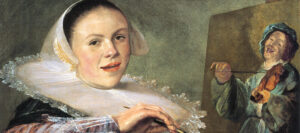
Judith Leyster: The painter of the Dutch Golden Age
Roberto ZampieriShare
In the artistic panorama of the Dutch Golden Age, an era characterized by a great artistic flowering, a surprising figure stands out: Judith Leyster. This extraordinary woman has left a significant imprint on the history of art , despite having long been overlooked and forgotten. Today, we will dive into the life and works of Judith Leyster, discovering the reasons why her figure has been rehabilitated and admired by modern scholars.
Born in Haarlem, Netherlands, in 1609, Judith Leyster grew up in a family environment that was stimulating for her artistic inclinations. Her father, Jan Willemsz Leyster, was a brewer and probably cultivated an interest in art in the young Judith. It is believed that she received artistic training from the painter Frans Pietersz de Grebber and became a member of the Guild of St. Luke, an association of artists and craftsmen.
Her decision to become a professional painter and her ability to do so successfully in the society of the time are elements that make Judith Leyster an extraordinary figure.
Judith Leyster's early works demonstrate her skill in portraying genre scenes , often with characters engaging in everyday activities such as music or reading. His most famous work in this genre is a lively depiction of a company of young people having fun around a table, which reflects the convivial atmosphere of the time. Leyster also showed a particular skill in the use of light and color, giving his works a sense of liveliness and realism.
In addition to genre portraits, Judith Leyster also excelled in individual portraiture . His works often portray women, both in calm poses and in lively and dynamic attitudes. One of her best-known portraits is "Self-portrait", where the painter represents herself with a confident and determined expression. This work represents a very bold self-portrait for the time, when women were often depicted only as passive subjects or objects of beauty.
Despite her talent and early success, Judith Leyster was not immune to the difficulties that women artists faced in the 17th century. Women had limited access to art academies and guilds, and often had to struggle to make their way in the male-dominated art world. However, Judith Leyster's fortunes changed when she married Jan Miense Molenaer , a successful painter who appreciated her talent and supported her in her career. Despite this, Leyster's works were often attributed to her husband or other male artists of the time.
Judith Leyster's reappraisal as a talented artist came only in the 20th century, when one of her paintings was erroneously attributed to Frans Hals, a famous Dutch painter of the time. Scholars began to delve deeper into the work and discover that it had actually been created by Leyster. This discovery led to a general reevaluation of his works and greater attention to his figure in the context of the Dutch Golden Age.
Today, Judith Leyster's artistic legacy is fully recognized . His works are exhibited in major museums around the world and are admired for their technical mastery and innovative spirit. Leyster proved that women can excel in art, despite the challenges and discrimination they face, and paved the way for many other painters who followed her.
Judith Leyster was an extraordinary woman who left a significant imprint on the art of the Dutch Golden Age. Her works, full of vitality and technical mastery, reflect her innate talent and her determination to overcome the obstacles that women artists faced in the society of the time. Thanks to the reevaluation of her figure, Judith Leyster is now recognized as one of the great painters of her time and a pioneer for women in art.
Judith Leyster's major works
- Serenade, oil on panel, 45.5 × 35 cm, c. 1629, Rijksmuseum, Amsterdam
- Self-portrait, oil on canvas, 74.6 × 65.3 cm, c. 1630, National Gallery of Art, Washington
- Merry company, oil on canvas, 68 × 55 cm, c. 1630, Louvre Museum, Paris
- A man offers money to a young woman, oil on panel, 30.9 x 24.2 cm, 1631, Mauritshuis, The Hague
- Tulip, from the Tulip Book, c. 1643, Frans Hals Museum, Haarlem
- Vase of flowers, oil on canvas, signed Judith Molenaer 1654 on the bottom, 1654, Frans Hals Museum, Haarlem
- Cheerful drunkard, oil on canvas, 89 × 85 cm, Frans Hals Museum, Haarlem
- Young flute player, oil on canvas, 73 x 62 cm, Nationalmuseum, Stockholm
These works are just a selection of the many works Judith Leyster created throughout her career. Each work represents a significant piece in her artistic output and contributes to her reputation as a talented 17th-century Dutch painter.
